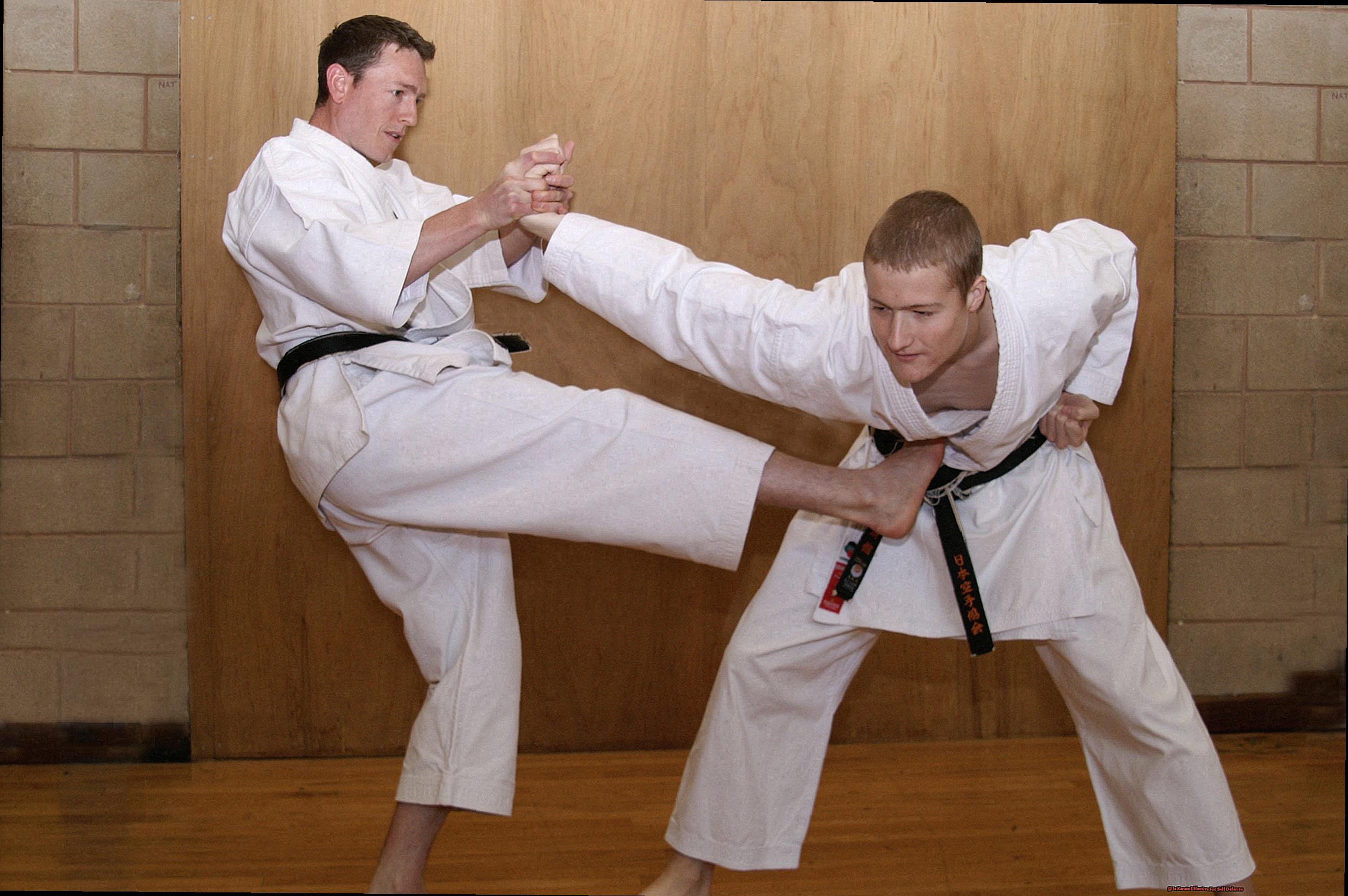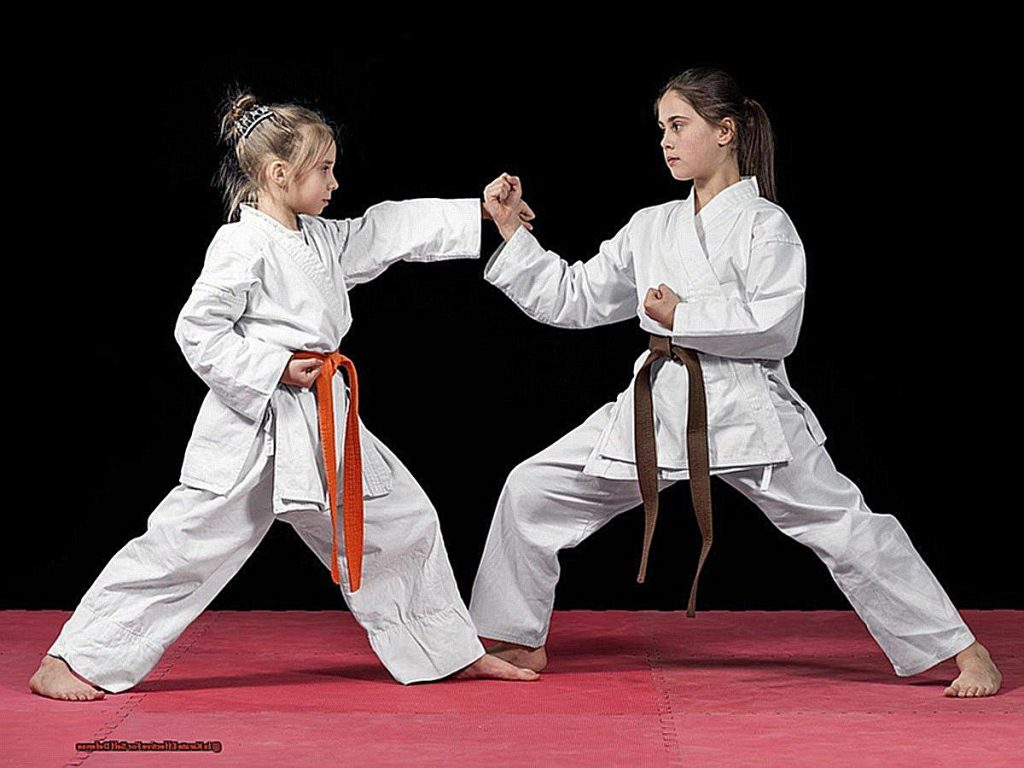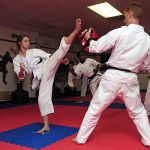Are you searching for a self defense practice that not only equips you with the skills to protect yourself, but also enhances your physical and mental well-being? Look no further than karate. This ancient martial art has stood the test of time and proven its effectiveness in real-life situations. But what sets karate apart from other forms of self defense? Let’s delve into the unique benefits of this powerful practice.
- Karate teaches practical and efficient techniques for defending against various attacks.
- It emphasizes using your body as a weapon, rather than relying on external tools.
- The physical training involved in karate improves strength, flexibility, and coordination.
- Mental discipline is also prioritized, enabling individuals to remain calm and focused in high-stress situations.
- Karate instills confidence and empowers individuals to take control of their safety.
- It can be practiced by people of all ages and fitness levels, making it accessible to anyone.
- The traditional values of respect, humility, and perseverance are deeply ingrained in the practice of karate.

In this blog post, we will delve deeper into the effectiveness of karate for self defense and explore why it is a valuable skill to have in today’s world. So put on your gi and get ready to discover the power of karate.
What is Karate?
The roots and inception of Karate as a combat method can be traced back to the Okinawa territory in the 7th century. It was developed by the local inhabitants as a means of self-protection when Japanese forces prohibited weapons. The term “Karate” itself means “empty hand” in Japanese, reflecting its origins as a fighting style that relies solely on bodily strength.
Karate was heavily influenced by ancient Chinese martial arts practices and Chinese Kenpo, a fusion of Chinese and Indian combat styles. This influence is evident in the various striking and grappling techniques utilized in Karate.
It was not until the 20th century when Karate was introduced to mainland Japan, where it rapidly gained popularity and spread to other regions of the world. With its growing recognition, numerous schools and systems were established, each with their own unique methods and training techniques.
One popular fable surrounding the origin of Karate is that it was brought to China by a Buddhist monk named Bodhidarma. He arrived in China to teach Zen Buddhism and also introduced a style of boxing that focused on strengthening both the body and mind.
Today, Karate continues to evolve and adapt, with various styles and approaches being taught globally. It has become renowned not only as a self-defense mechanism but also for its physical and mental benefits, such as boosting confidence, body balance, reflexes, and overall fitness.
Does Karate work in a self-defense situation?
The answer is yes, but it requires more than just basic training and following strict rules. In order to truly utilize Karate as a form of self-defense, one must be able to adapt to real-life situations and scenarios.
One of the main drawbacks of relying solely on Karate for self-defense is its emphasis on single techniques and rigid footwork. In a real-life scenario, these techniques may not always work as intended, and practitioners must learn to improvise and adapt their techniques in order to effectively defend themselves.
However, it is important to note that the origins of Karate lie in personal protection and self-defense. With a focus on self-discipline and mental strength, it teaches practitioners to remain calm and composed in high-pressure situations.
Proper training is essential in utilizing Karate for self-defense. This includes practicing with a resisting partner and learning ground grappling techniques, which are not typically taught in traditional Karate classes. By incorporating these elements, the effectiveness of Karate in combat or self-defense situations can greatly improve.
Furthermore, it is worth mentioning that katas (choreographed moves) often contain grappling, choking, throwing, and joint locking techniques that are highly effective in combat scenarios. While these moves may not be explicitly taught or practiced in traditional Karate classes, they are still present in the art.
It is also important to keep in mind that it takes 3-5 years of training to reach Black Belt status in Karate. This reflects the level of skill and mastery required to effectively use Karate in self-defense situations.
What techniques are used in Karate to fight an attacker?
Karate includes a variety of techniques that are utilized to protect oneself against an assailant. These techniques encompass strikes, blocks, throws, joint locks, and ground grappling. Each technique has its own unique strengths and can be applied in different situations depending on the attacker’s actions.
- Strikes: Karate puts emphasis on the use of quick and forceful strikes as a means of inflicting damage on an attacker. Common striking techniques include punches, kicks, knee strikes, and elbow strikes. These strikes are directed towards vulnerable areas like the eyes, nose, throat, and groin to incapacitate or disorient an attacker.
- Blocks: In addition to striking techniques, karate also teaches various blocking techniques that can be used to defend against incoming attacks. These blocks are meant to redirect an attacker’s strike or throw them off balance. Practitioners are trained to effectively use their arms, hands, and legs for blocking attacks.
- Throws: Throws are an essential aspect of self-defense training in karate. These techniques are employed to create distance between the defender and attacker or to restrain the attacker on the ground. Proper body positioning, balance, and timing are crucial for successfully executing throws.
- Joint Locks: Joint locks are another effective technique in self-defense that can immobilize an attacker by manipulating their joints or limbs. This technique is particularly useful when facing a larger or stronger opponent.
- Ground Grappling: In real-life scenarios, attackers may attempt to take the fight to the ground. In such situations, karate practitioners who have training in ground grappling techniques have an upper hand as they can defend themselves while standing or on the ground.
- Kata Techniques: Kata is a series of choreographed movements that simulate fighting against multiple attackers. Practicing kata helps develop muscle memory and reaction time, making it a valuable technique in self-defense situations.
Karate offers a diverse range of techniques that can be utilized for self-defense. However, it is essential to note that the effectiveness of these techniques largely depends on the practitioner’s training, physical conditioning, and ability to adapt to different situations.
Does Karate work in a street fight?
From my own experience and extensive research, I have found that Karate can be a highly effective form of self-defense in real-life scenarios, including street fights. However, it is important to note that not all Karate schools or styles may be suitable for these types of situations.
One of the key factors that contribute to the practicality of Karate in self-defense is its emphasis on speed and agility. In a street fight, quick and precise movements are crucial in protecting oneself against an attacker. Through various drills and sparring exercises, Karate training helps to develop these essential skills.
Moreover, the techniques used in Karate are specifically designed for close combat situations. Strikes, blocks, and throws are all highly effective in close-range fighting, making them useful in street fights where space may be limited. Additionally, Karate also includes joint locks and ground grappling techniques, which can quickly neutralize an attacker.
However, it is important to note that not all Karate schools or styles may be suitable for real-life confrontations. Some schools prioritize tournament sparring and katas over practical self-defense techniques, which may not be as effective in real-life situations. It is crucial to choose a school or style that prioritizes self-defense training and real-life application over competitions.
Furthermore, while Karate can be a powerful tool for self-defense, it is not a guarantee of success in every street fight scenario. Every situation is unique, and there are no guarantees in a real-life confrontation. The best defense is always to try and avoid confrontations and de-escalate any potentially dangerous situations.
And, based on my experience and research, I firmly believe that Karate can be a highly practical form of self-defense in real-life situations such as street fights.
Is Karate one of the best martial arts for self-defense?
Karate is widely considered to be one of the most effective martial arts for self-defense due to its emphasis on practical techniques and mental discipline. There are various factors that contribute to Karate’s reputation as a top choice for self-defense, including its effective striking techniques, mental focus, distance control, body conditioning, and realistic training.
Firstly, Karate is known for its powerful and precise strikes, utilizing a range of kicks, punches, and open-handed techniques to quickly disable an opponent. This makes it an ideal form of self-defense in close-range situations where quick and precise movements can make all the difference.
Moreover, Karate also teaches mental focus and discipline in addition to physical techniques. This can be crucial in a self-defense scenario, helping individuals to remain calm and focused under pressure, which is essential for successfully defending oneself.
Another key aspect of Karate is its emphasis on controlling the distance between you and your opponent. By understanding how to effectively control the distance, individuals can evade attacks and create openings for their own strikes. This is a vital skill in real-life confrontations.
Additionally, certain styles of Karate, such as Kyokushin, place a strong emphasis on physical conditioning through full-contact sparring and body toughening exercises. This prepares individuals for the physical demands of a real fight and improves their overall fitness and endurance.
Furthermore, realistic training is crucial for self-defense situations. Many Karate schools incorporate sparring and scenario-based training to prepare students for real-life confrontations. This type of training ensures that individuals are equipped with the necessary skills and strategies to defend themselves effectively.
Karate’s combination of effective striking techniques, mental focus, distance control, body conditioning, and realistic training make it one of the best martial arts for self-defense. However, it is important to choose a school or style that prioritizes self-defense training and understand that there are no guarantees in a real-life confrontation.
Easy to learn
When it comes to learning the art of self defense through karate, one must possess dedication, commitment, and patience. While it may take an average of 3-5 years to reach the prestigious black belt level, basic self defense skills can be acquired within a few short months with consistent training. This is what makes karate such an accessible and versatile form of self defense for individuals of all ages and physical capabilities.
Unlike other forms of martial arts, karate does not require a specific body type or level of athleticism. In fact, anyone can learn and excel in this discipline with proper guidance and effort. This is what sets karate apart from other self defense methods – its inclusivity and adaptability.
However, do not be fooled by its approachability. Karate still requires a great deal of discipline and hard work. It is not something that can be learned overnight or through shortcuts. As the saying goes, “Rome wasn’t built in a day.” Similarly, mastering the art of karate takes time and effort.
But do not let that discourage you. Karate offers a sense of accomplishment like no other. The journey from white belt to black belt is not just about learning how to defend yourself, it is also about personal growth and development. Along the way, one learns important values such as respect, discipline, and perseverance.
So, whether you are looking for a way to protect yourself or to grow as an individual, karate is an excellent choice.
Safe and effective
Yes, karate is widely recognized as a secure and efficient means of protecting oneself. This martial art has a rich history and is rooted in close combat tactics. It instructs students on how to anticipate and respond swiftly in potentially perilous situations. Additionally, practicing karate can enhance physical strength, flexibility, coordination, confidence, and discipline. It can also serve as a stress-reliever and aid in reducing anxiety and depression.
Traditional karate, which emphasizes self-defense, is often viewed as more practical for real-life scenarios compared to sport karate, which prioritizes rules and regulations for competition. However, both forms of karate can still be beneficial for developing self-defense skills.
To ensure the safety and effectiveness of learning karate for self-defense, it is crucial to find a reputable instructor and maintain regular practice. This will assist in honing proper techniques and muscle memory for swift reactions in dangerous situations.
Moreover, the future of karate is continually evolving, keeping it relevant as a martial art for self-defense.
How do you train at home in Karate?
Training at home in Karate for self-defense purposes can be a convenient and effective way to enhance your skills and stay prepared for potential dangers. Below are some efficient methods to train at home in Karate for self-defense:
- Allocate a specific time every day: Consistency is crucial in any martial art training, and karate is no exception. Set aside a particular time each day to practice your techniques, whether it’s before or after work, or even during your lunch break. This will help you establish a routine and improve your skills over time.
- Focus on posture and equilibrium: In karate, balance and center of gravity are essential in maintaining stability and executing powerful strikes. Practice spreading your feet to lower your center of gravity and quickly shifting your balance between stances. Avoid staying in one stance for too long, as this can make you vulnerable to attacks.
- Use a life-sized dummy bag: A life-sized dummy bag, also known as a “BOB,” is an excellent investment for practicing karate at home. It is an adjustable dummy that can be set to different heights and angles, allowing you to practice various strikes, kicks, and blocks with accuracy and power.
- Warm-up and stretch: Before diving into your karate training, make sure to warm up and stretch your muscles. This will not only prevent injuries but also improve your flexibility and range of motion, making it easier to execute techniques.
- Train with a partner or family member: If possible, train with a partner or family member who shares an interest in karate. This will not only make training more enjoyable but also provide an opportunity to practice self-defense techniques together.
- Utilize online resources: With the advancement of technology, there are now numerous online resources available for learning karate at home. From instructional videos to virtual classes, these resources can supplement your training and provide valuable insights into proper techniques and forms.
| Method | Description | Benefits |
| Kata | Kata is a series of choreographed movements that simulate fighting against multiple opponents. It helps to improve muscle memory, coordination, and focus. | – Enhances muscle memory and coordination – Increases focus and concentration – Develops techniques for fighting multiple opponents |
| Kumite | Kumite is a sparring exercise where students practice fighting against an opponent. It helps to improve reaction time, reflexes, and strategy. | – Improves reaction time and reflexes – Enhances sparring skills and techniques – Develops strategy and adaptability in a fight |
| Bag Work | Bag work involves striking or kicking a punching bag or body opponent bag. It helps to improve power, speed, and accuracy in strikes. |
Conclusion
In summary, it is evident that karate is a formidable form of self-defense that offers a plethora of physical and mental advantages.
Its focus on practical techniques, mental fortitude, and traditional values sets it apart from other self-defense methods. With consistent practice and determination, one can acquire the necessary skills to effectively defend themselves in real-life scenarios.






